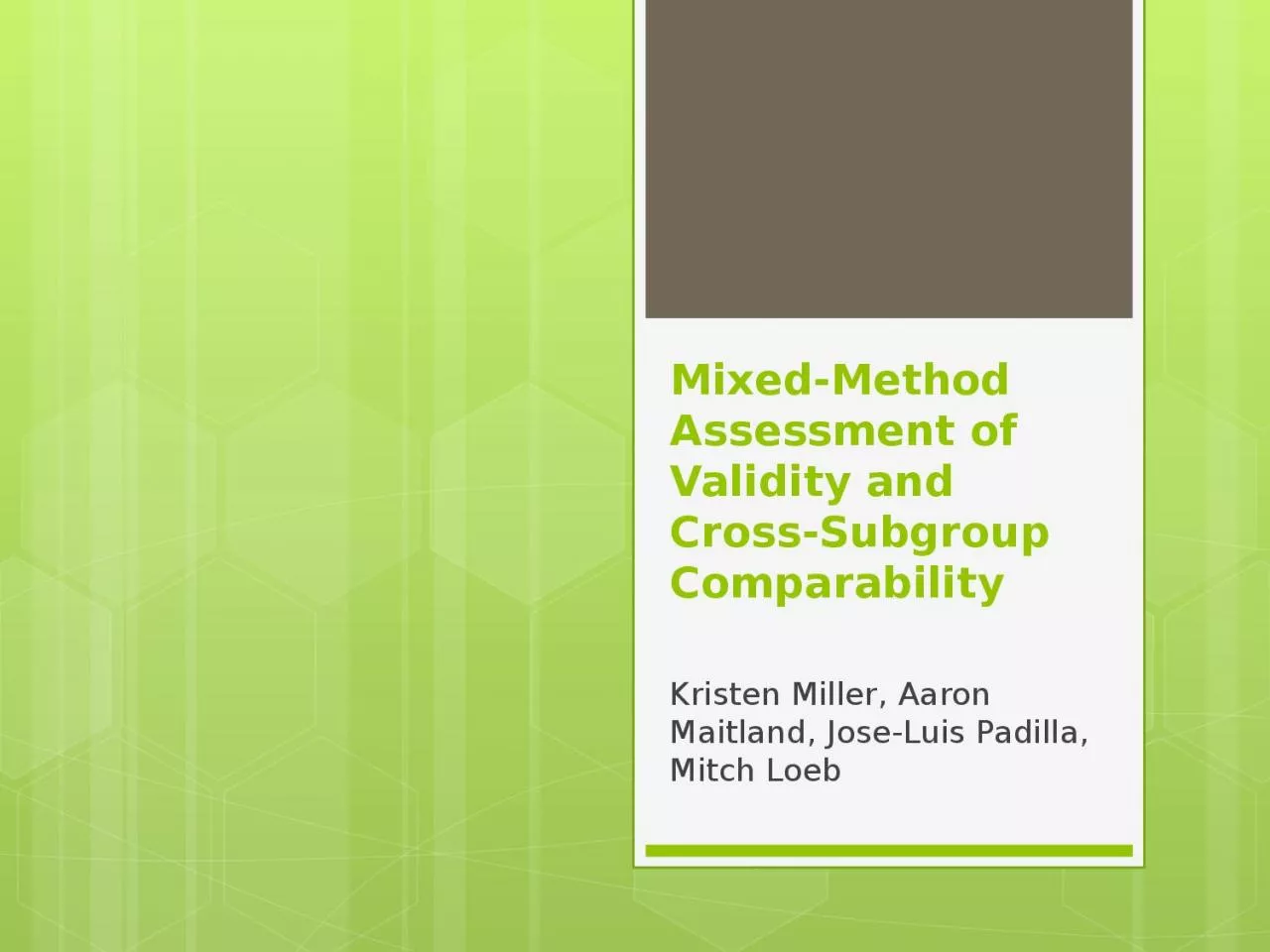

Comparability Kristen Miller Aaron Maitland JoseLuis Padilla Mitch Loeb Pain Questions In the past 3 months how often did you have pain Would you say never some days most days or every day ID: 999037
Download Presentation The PPT/PDF document "Mixed-Method Assessment of Validity and..." is the property of its rightful owner. Permission is granted to download and print the materials on this web site for personal, non-commercial use only, and to display it on your personal computer provided you do not modify the materials and that you retain all copyright notices contained in the materials. By downloading content from our website, you accept the terms of this agreement.
1. Mixed-Method Assessment of Validity and Cross-Subgroup ComparabilityKristen Miller, Aaron Maitland, Jose-Luis Padilla, Mitch Loeb
2. Pain QuestionsIn the past 3 months, how often did you have pain? Would you say never, some days, most days or every day?[If at least some days] Thinking about the last time you had pain, how much pain did you have? Would you say a little, a lot, or somewhere in between?
3. Descriptive Follow-up QuestionsPlease tell me which of the following statements, if any, describe your pain.It is constantly present. Sometimes I’m in a lot of pain and sometimes it’s not so bad.Sometimes it is unbearable and excruciating. When I get my mind on other things, I am not aware of the pain. Medication can take my pain away completely. My pain is because of work. My pain is because of exercise.
4. Field Interviews2010 National Health Interview SurveySubset: ¼ of HIS; N=6775Interviewer administered
5. Results:FrequencyUnweighted NWeighted PercentNever263138.5%Some days228934.9Most days4866.8Every day70910.4Missing6609.6Total6775100IntensityUnweighted NWeighted PercentA little169147.3%Closer to a little2758.3Exactly in the middle56416.8Closer to a lot2608.2A lot67317.7Missing761.8Total3539100
6. FrequencyIntensitySome daysMost daysEvery dayA little41.7% (n=1442)3.8% (n=133)3.2% (n=112)Closer to a little 5.8% (n=199)1.2% (n=40)1.0% (n=36)Exactly in the middle8.8% (n=303)3.4% (n=118)4.1% (n=143)Closer to a lot3.2% (n=109)1.6% (n=55)2.8% (n=96)A lot6.4% (n=220)4.0% (n=139)9.1% (n=314)
7. Descriptive Follow-Up Variables Percent of Respondents Describing Pain Constantly present31.1Fluctuating55.6Unbearable25.1Not always aware48.3Medication alleviates43.4
8. FrequencyIntensitySome daysMost daysEvery dayA little41.7% (n=1442)3.8% (n=133)3.2% (n=112)Closer to a little 5.8% (n=199)1.2% (n=40)1.0% (n=36)Exactly in the middle8.8% (n=303)3.4% (n=118)4.1% (n=143)Closer to a lot3.2% (n=109)1.6% (n=55)2.8% (n=96)A lot6.4% (n=220)4.0% (n=139)9.1% (n=314)Problem if: Constant or unbearable (False Negative)Problem if: Medicine takes away or sometimes not aware (False Positive)
9. Percent of problem casesConsistent92.41False Negative2.83False Positive4.77
10. Demographic analysis of problem casesAgeYoungNot YoungOlderEven OlderOldestConsistent93.793.592.892.390.7False Negative4.62.22.82.42.2False Positive1.64.34.45.37.8
11. Demographic analysis of problem casesEducationLeast EducatedIn-Between EducatedMost EducatedConsistent88.290.794.2False Negative4.33.32.3False Positive7.66.03.5
12. Demographic analysis of problem casesIncomePoorLess PoorLess WealthyWealthiestConsistent89.593.394.295.0False Negative3.03.43.51.3False Positive7.63.42.33.8
13.